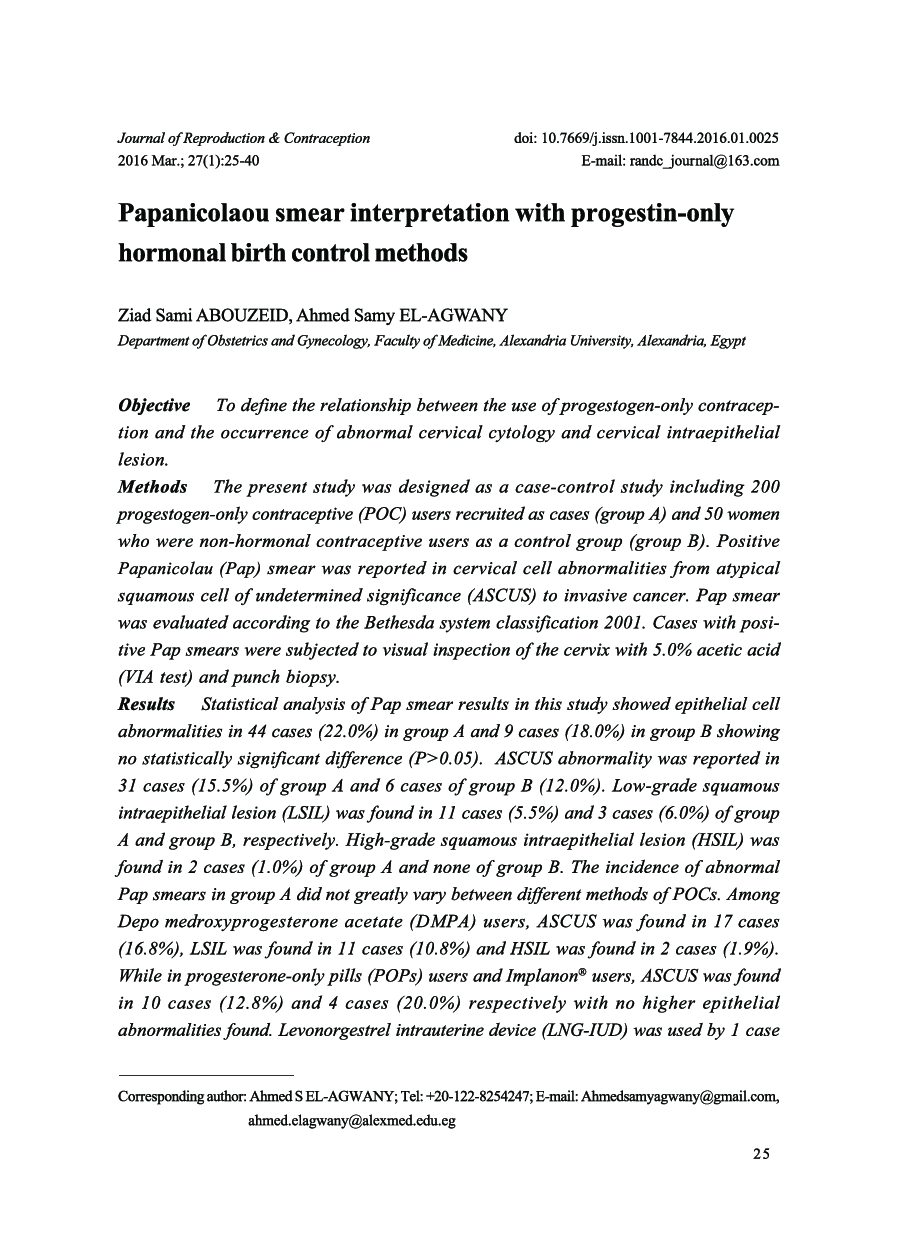| Article ID | Journal | Published Year | Pages | File Type |
|---|---|---|---|---|
| 3963897 | Journal of Reproduction and Contraception | 2016 | 16 Pages |
ObjectiveTo define the relationship between the use of progestogen-only contraception and the occurrence of abnormal cervical cytology and cervical intraepithelial lesion.MethodsThe present study was designed as a case-control study including 200 progestogen-only contraceptive (POC) users recruited as cases (group A) and 50 women who were non-hormonal contraceptive users as a control group (group B). Positive Papanicolau (Pap) smear was reported in cervical cell abnormalities from atypical squamous cell of undetermined significance (ASCUS) to invasive cancer. Pap smear was evaluated according to the Bethesda system classification 2001. Cases with positive Pap smears were subjected to visual inspection of the cervix with 5.0% acetic acid (VIA test) and punch biopsy.ResultsStatistical analysis of Pap smear results in this study showed epithelial cell abnormalities in 44 cases (22.0%) in group A and 9 cases (18.0%) in group ? showing no statistically significant difference (P>0.05). ASCUS abnormality was reported in 31 cases (15.5%) of group A and 6 cases of group ? (12.0%). Low-grade squamous intraepithelial lesion (LSIL) was found in 11 cases (5.5%) and 3 cases (6.0%) of group A and group B, respectively. High-grade squamous intraepithelial lesion (HSIL) was found in 2 cases (1.0%) of group A and none of group B. The incidence of abnormal Pap smears in group A did not greatly vary between different methods of POCs. Among Depo medroxyprogesterone acetate (DMPA) users, ASCUS was found in 17 cases (16.8%), LSIL was found in 11 cases (10.8%) and HSIL was found in 2 cases (1.9%). While in progesterone-only pills (POPs) users and Implanon® users, ASCUS was found in 10 cases (12.8%) and 4 cases (20.0%) respectively with no higher epithelial abnormalities found. Levonorgestrel intrauterine device (LNG-IUD) was used by 1 case in group A and was not associated with Pap smear abnormality. Cases with ASCUS abnormality were followed up by repeated Pap smear after 3 months. Twenty cases (64.5%) and 3 cases (50.0%) of groups A and B, respectively showed complete regression to normal. Eleven cases (35.5%) and 3 cases (50.0%) of groups A and ? respectively showed persistent features of ASCUS. Punch biopsy was done in cases with higher grade epithelial lesions (LSIL & HSIL) showing 4 cases (30.8%) with mild dysplasia or CIN I, 2 cases (15.4%) with moderate dysplasia in group A, 2 cases (66.7%) with mild dysplasia and 1 case (33.3%) with moderate dysplasia in group B. Seven cases (53.8%) of group A showed cytological abnormality without concurrent dysplasia seen in histopathological examination. None of the included cases in this study were active smokers, while in group A passive smoking was found in 44 cases with abnormal Pap smear (100.0%) including 31 ASCUS cases (100.0%), 11 LSIL cases (100.0%) and 2 HSIL cases (100.0%). In group ? passive smoking was found in 9 cases with Pap smear abnormality including 6 ASCUS cases (100.0%), 3 LSIL cases (100.0%). There was a statistically significant difference between cases with normal and abnormal Pap smears regarding smoking status.ConclusionPOCs use is not associated with increased risk of abnormal cytologic findings and preinvasive disease of the cervix. Smoking including passive smoking has a positive association with abnormal Pap smears. The use of the Bethesda system for cytological interpretation is a simple and accurate method for management of abnormal cytology.
